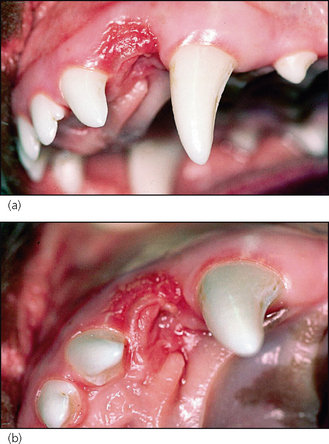25 Rubber toy technique and alveoloplasty
ORAL EXAMINATION – CONSCIOUS
5. Lower canine occluding with gingiva at diastema between the upper third incisor and upper canine bilaterally, causing indentations and gingival hyperplasia (Fig. 25.1a, b)
6. Diastema between the upper third incisor and upper canine of adequate size for lower canine to fit bilaterally (Fig. 25.1a, b).
THEORY REFRESHER
In this case, the upper and lower jaw were of normal length; the mandible was narrow with respect to the upper jaw, but there was sufficient diastema for the lower canines to form a correct interlock if they were moved just slightly laterally.
• Incorrect dental interlock will interfere with the normal growth in width and length of the developing mandible.
• The use of a removable orthodontic appliance (‘rubber toy’ technique) has proved to be successful in correcting the malocclusion within 4 weeks.
• The diastema between the third incisor and canine tooth in the upper jaw should be wide enough to accommodate the mandibular canine tooth in its corrected position.
Stay updated, free articles. Join our Telegram channel

Full access? Get Clinical Tree



